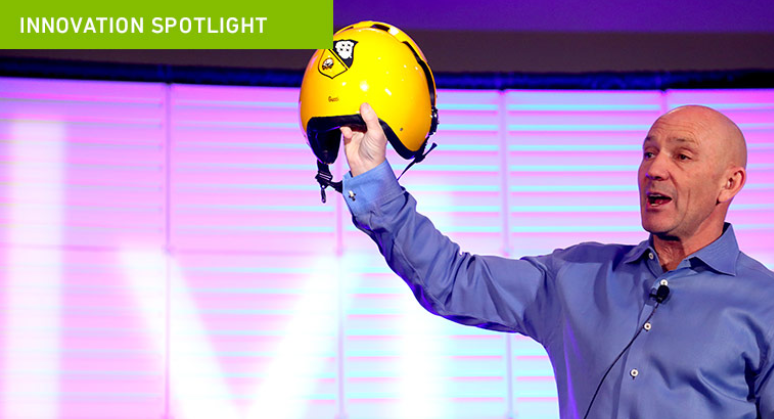Former Blue Angels solo pilot John Foley, speaking at the 2018 Lytx User Group Conference in San Diego. Credit: Lytx.
The next time you’re at a party and people ask you what you do for a living, you can tell them that your work is a lot like flying an F/A 18 Hornet at 500 mph.
It’s true. You can cite John Foley, a former lead solo pilot for the Blue Angels, who spoke at this year’s Lytx User Group Conference, about how being a safety professional has many parallels to being part of the U.S. Navy's elite flight squadron.
Foley, who is among a handful of American military pilots to have flown with the Russian Knights over Moscow, drew five key similarities between those who operate driver safety programs and those who operate 22-ton military jets at 15,000 feet:
1. Having the right information, when you need it, is critical.
When you’re flying at 500 mph and as close as 18 inches apart from the jet next to you, you need timely information. In addition to timely communication with their team members, pilots rely on their instruments to make decisions. The ability to know exactly what’s happening can make the difference between life and death.
It’s the same with safety professionals, who need data to understand what’s happening on the road so they can keep their drivers and communities safe.
“When there’s a gap between where you are and where you want to go, we say, ‘Give me three solutions for closing that gap.’ We did this all the time,” Foley said of the Blue Angels. “Video telematics helps you measure that gap. How do you close the gap? Because that is where the coaching comes in. That’s where the behavior change comes in.”
2. Being a “learning organization” can lead to even higher performance.
Even though the Blue Angels are among the best pilots in the world, they never stop trying to improve. When he began his Blue Angel training, Foley was already an accomplished Navy pilot who could maintain a 10-foot distance between his jet and the one next to him.
“But 10 feet wasn’t good enough,” Foley said. He needed to safely shave that down to 36 inches. “There’s a way to do it. It’s not just about process, it’s mindset. It starts with belief.”
The Angels systematically train their pilots by being what he calls a “learning organization,” one that believes it and its pilots can always do better.
“Human beings don’t perform at our full potential. We perform at our level of belief. It you lift the belief, success will happen. So, ask yourself this question: How good do you want to be? Can you get to zero [safety events a month]? Can you get beyond zero? What does that mean? Once you get clarity on those questions, you can come up with the process and systems to get to that number.”
3. Fast feedback is strong feedback when it comes to coaching.
In his talk, Foley showed a rare video clip of what happens inside the Blue Angels’ briefing room, where outsiders are rarely, if ever, allowed. Pilots review video clips of their performance, much in the same way drivers and safety professionals review DriveCam video. They also take turns critiquing each other and themselves in unflinching evaluations that go straight to the point. Nothing is sugarcoated, and each team member acknowledges what has to be done to improve.
“We make mistakes, and we fess up to them,” Foley said. Each pilot is saying, “‘I made these mistakes, and I will fix it. I will take corrective action.’ It doesn’t drop our confidence in the other person [when pilots own their mistakes].”
Safety coaches, too, can use this technique to connect with their drivers, align their safety goals, and get drivers to acknowledge their errors—and commit to improvement.
4. The people in an organization can change, but culture is lasting.
The Blue Angels, by design, have a high rate of turnover. Officers on the team serve two to three years, and the enlisted personnel serve three to four years. That creates a challenge similar to that faced by those who oversee the safety programs of drivers, a workforce with high turnover rates.
“How do you sustain excellence when you have changing people, conditions, drivers?” Foley rhetorically asked. “The way you do that is [through] culture—a culture of excellence, a culture of caring.”
And, of course, a culture of safety.
5. Focusing on the positive can lead to change.
In the same video, each pilot ends his critique by saying, “Glad to be here.” The statement represents gratitude, and Foley calls it the Blue Angels’ “secret sauce.”
“It’s a powerful statement,” Foley said. It says, “If you want people to change, you have to be the light.”
The Blue Angels’ mantra dovetails with the emphasis that safety coaches at the User Group Conference placed on positive coaching methods and peer recognition to reduce risky driving behavior. For safety professionals, being “glad to be here” can mean continuing to make a difference, continuing to save lives, Foley said.
“You’re actually impacting someone’s life,” he said. “You may not know it. They might not tell you. But it’s worth doing.”
What is your organization doing to impact people’s lives for the better? The ebook Driver Incentives That Work can help get you started on that journey.
Interested in hearing more from John Foley on what it means to be “glad to be here?” Text the code ‘gtbh’ to the number 797979 to access his presentation.
